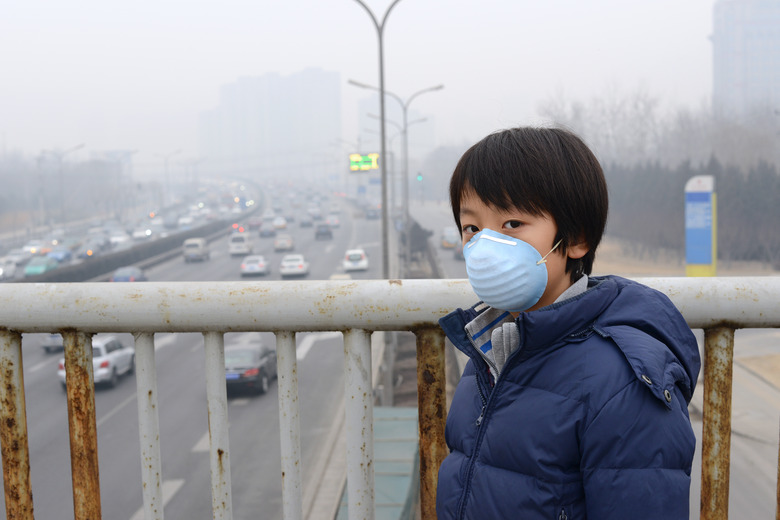What Place In The World Receives The Most Acid Rain?
Acid rain is responsible for severe environmental destruction across the world and occurs most commonly in the North Eastern United States, Eastern Europe and increasingly in parts of China and India. According to the Environmental Protection Agency (EPA) acid rain can be particularly damaging to the young from many species of plant and wildlife.
TL;DR (Too Long; Didn't Read)
Too Long Didn't Read
Acid rain is a serious environmental threat and when left unchecked in countries with lax emission laws it can negatively affect animals and plant life and the structure of buildings for generations.
What is Acid Rain?
What is Acid Rain?
Nitrogen oxide and sulfur dioxide are polluting byproducts of soft-coal-burning power plants and factories, and are the main culprits in the production of acid rain. When these chemicals combine with water and particulates in the atmosphere, the result is precipitation, which includes rain, snow and fog, laden with nitric and sulfuric acids, otherwise known as acid rain.
The Black Triangle
The Black Triangle
Covering areas of the Czech Republic, Germany and Poland, the Black Triangle is an area that received heavy acid rain throughout the 1970s and 80s. In parts of the Black Triangle, entire forests were dead or dying and even railroad tracks were being corroded by the acidic precipitation. The emissions of coal-burning factories in Eastern Europe came under strict regulation by the Geneva Convention of 1979 to prevent further acid rain pollution, a measure that has been successful in significantly reducing acid deposition in the region.
Eastern United States
Eastern United States
Parts of the Eastern United States were also once plagued by some of the highest levels of acid rain in the world, due to emissions from Midwestern coal-burning power plants. In parts of New Jersey, for example, over 90 percent of freshwater streams are still acidic today due to acid rain, according to the U.S. Environmental Protection Agency. While the effects of acid rain are still felt in the region, acid rain itself has significantly decreased as a result of the Clean Air Act of 1970 and its subsequent amendments.
Changing Trends
Changing Trends
Because of the laws enacted in the United States and Europe regulating emissions from coal-burning factories, and the adoption of mitigating technologies, such as limestone injection burners, reburners, flue gas desulphurizers and low-sulfur burners, these areas receive less acid rain today than in the past, according to a report from the environmental watchdog group Earthwatch Institute. The habitats in these countries suffered extensive damage and recovery is slow, but international concern over acid rain has since shifted focus to other parts of the world. In China and India, rapid industrial growth and lax pollution regulations could combine to produce the highest levels of acid rain in the developing world.
Acid Rain in Asia
Acid Rain in Asia
Since the year 2000, levels of nitric and sulfuric acid in precipitation have been steadily increasing in Asian cities such as Beijing and New Delhi as domestic demand for electricity and manufactured goods increases. Without pollution regulations on the rapid industrial growth in the developing nations of China and India, acid rain could continue to grow in potency and reach until a similar crisis level as seen in Europe and the United States in the 1980s, according to a report by Science News.
Solutions and Ways Forward
Solutions and Ways Forward
In the United States, there are measures to protect the environment from the effects of acid rain including the EPA's Acid Rain program developed following the Clean Air Act Amendment of 1990 which aims to lower sulfur dioxide emissions from power plants. Responsible steps like these, towards lowering contaminants in the air can help to halt the destruction of acid rain.
Cite This Article
MLA
Echolls, Taylor. "What Place In The World Receives The Most Acid Rain?" sciencing.com, https://www.sciencing.com/place-world-receives-acid-rain-23289/. 30 April 2018.
APA
Echolls, Taylor. (2018, April 30). What Place In The World Receives The Most Acid Rain?. sciencing.com. Retrieved from https://www.sciencing.com/place-world-receives-acid-rain-23289/
Chicago
Echolls, Taylor. What Place In The World Receives The Most Acid Rain? last modified August 30, 2022. https://www.sciencing.com/place-world-receives-acid-rain-23289/
